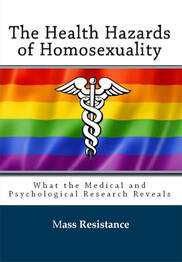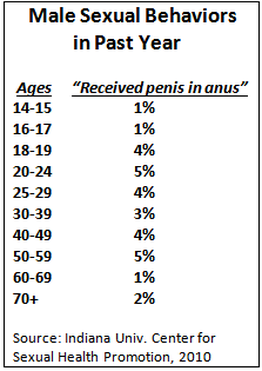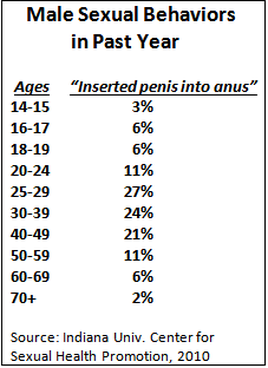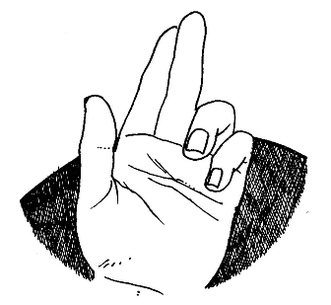
"Gay" (MSM) Sexual Practices & Disease
How Today’s “Gay” Subculture Is Different
(excerpt from Chapter 6)
Researcher Dale O’Leary notes the historically unique character of today’s male homosexual subculture:
Sex between males has gone on in various cultures and periods, with different levels of social acceptance or condemnation and involving different types of behaviors. The modern gay rights movement is unique, in terms of the number of extreme behaviors, the multiple concurrent sexual partners, the reciprocal nature of the acts, and the use of sex-enhancing and mind-altering drugs... [The political “gay rights movement has had] reverberating social implications, including for the eventual design of the global HIV/AIDS response… Freed from legal harassment, gay culture was freed to focus on the glorification of promiscuity.
A lifestyle of absolute sexual freedom has been facilitated by the explosion of Internet pornography and “dating” sites, and more recently phone apps, intensifying the MSM ["men who have sex with men"] public health crisis in the past decade.
Every excess imaginable is now “out and proud”: Bathhouses and sex clubs operate openly. A Chicago museum celebrates perverted acts and the “leather” subculture. Major media advertise and publish X-rated photos from events such as the “Black Party” in New York City. Nudity, sexual sadomasochism, and live sex acts take place in the streets of San Francisco with police protection. Major hotel chains welcome conventions celebrating dangerous “lifestyles” and practices. Law enforcement has been AWOL on policing male prostitution sites and sex trafficking (with the exception of the recent crackdown on Rentboy; see Chapter 7).
Furthermore, societal acceptance of homosexuality (and bisexuality) and the attempted normalization of sodomy and BDSM have led to an increasing segment of the population engaging in these medically dangerous practices.
(excerpt from Chapter 6)
Researcher Dale O’Leary notes the historically unique character of today’s male homosexual subculture:
Sex between males has gone on in various cultures and periods, with different levels of social acceptance or condemnation and involving different types of behaviors. The modern gay rights movement is unique, in terms of the number of extreme behaviors, the multiple concurrent sexual partners, the reciprocal nature of the acts, and the use of sex-enhancing and mind-altering drugs... [The political “gay rights movement has had] reverberating social implications, including for the eventual design of the global HIV/AIDS response… Freed from legal harassment, gay culture was freed to focus on the glorification of promiscuity.
A lifestyle of absolute sexual freedom has been facilitated by the explosion of Internet pornography and “dating” sites, and more recently phone apps, intensifying the MSM ["men who have sex with men"] public health crisis in the past decade.
Every excess imaginable is now “out and proud”: Bathhouses and sex clubs operate openly. A Chicago museum celebrates perverted acts and the “leather” subculture. Major media advertise and publish X-rated photos from events such as the “Black Party” in New York City. Nudity, sexual sadomasochism, and live sex acts take place in the streets of San Francisco with police protection. Major hotel chains welcome conventions celebrating dangerous “lifestyles” and practices. Law enforcement has been AWOL on policing male prostitution sites and sex trafficking (with the exception of the recent crackdown on Rentboy; see Chapter 7).
Furthermore, societal acceptance of homosexuality (and bisexuality) and the attempted normalization of sodomy and BDSM have led to an increasing segment of the population engaging in these medically dangerous practices.
|
Dick is loved at 2014 Boston Gay Pride. (MassResistance photo)
|
MSM Sexual Practices
(excerpt from Chapter 8)
MSM engage in a variety of unnatural and unhealthy sexual practices. Statistics are hard to come by on what proportion of the MSM group engages in any one of these practices, or the frequency among those who do.
The CDC clearly affirms “gay” sexuality, and apparently aims to soften the dark truth. The agency’s effort to normalize homosexuality is captured in the romanticized – sometimes suggestive – photos of smiling or embracing male couples that accompany their information pages.
The CDC does not describe the typical “gay” practices, so we had to turn to “gay” websites and books for a better understanding.
A 1979 survey by homosexual authors, The Gay Report, showed:
… the percentage of gay men who engaged in the following practices: 99% oral sex, 91% anal sex, 82% rimming (anilingus), 22% fisting, 23% golden showers (urination on another), 4% scat (defecation on another). The book’s two authors were of same-sex sexual attraction.
A May 2011 medical journal article found that felching (“sucking or eating semen out of someone's anus”) was a sought-after practice in one-sixth of men’s profiles in “one of the largest Internet websites specifically targeting MSM looking for partners for unprotected sex.”
An online survey in 2011 (reported in the Journal of Sexual Medicine) with responses from almost 25,000 men revealed only their most recent sexual behavior with another man:
Participants’ mean age was 39.2 years … and most men (79.9%) identified as homosexual. The most commonly reported behavior was kissing a partner on the mouth (74.5%), followed by oral sex (72.7%), and partnered masturbation (68.4%). Anal intercourse occurred among less than half of participants (37.2%) and was most common among men ages 18–24 (42.7%). Sex was most likely to occur in the participant's home (46.8%), with less frequently reported locations including hotels (7.4%) and public spaces (3.1%). The number of behaviors engaged in during last sexual event varied, with most (63.2%) including 5–9 different sexual behaviors....
A glossary from a British website for “gay” men, HardCell, lists and describes the sexual practices common among its readers. The raw language is theirs – it is the “gay” vernacular. This website, cited often below, is “produced by Terrence Higgins Trust, the UK’s leading HIV and sexual health charity.” This AIDS charity doles out “safer sex” advice that is indistinguishable from pornography.
We will examine each of these common MSM practices (noted at HardCell and other “gay” sources) in detail...
(excerpt from Chapter 8)
MSM engage in a variety of unnatural and unhealthy sexual practices. Statistics are hard to come by on what proportion of the MSM group engages in any one of these practices, or the frequency among those who do.
The CDC clearly affirms “gay” sexuality, and apparently aims to soften the dark truth. The agency’s effort to normalize homosexuality is captured in the romanticized – sometimes suggestive – photos of smiling or embracing male couples that accompany their information pages.
The CDC does not describe the typical “gay” practices, so we had to turn to “gay” websites and books for a better understanding.
A 1979 survey by homosexual authors, The Gay Report, showed:
… the percentage of gay men who engaged in the following practices: 99% oral sex, 91% anal sex, 82% rimming (anilingus), 22% fisting, 23% golden showers (urination on another), 4% scat (defecation on another). The book’s two authors were of same-sex sexual attraction.
A May 2011 medical journal article found that felching (“sucking or eating semen out of someone's anus”) was a sought-after practice in one-sixth of men’s profiles in “one of the largest Internet websites specifically targeting MSM looking for partners for unprotected sex.”
An online survey in 2011 (reported in the Journal of Sexual Medicine) with responses from almost 25,000 men revealed only their most recent sexual behavior with another man:
Participants’ mean age was 39.2 years … and most men (79.9%) identified as homosexual. The most commonly reported behavior was kissing a partner on the mouth (74.5%), followed by oral sex (72.7%), and partnered masturbation (68.4%). Anal intercourse occurred among less than half of participants (37.2%) and was most common among men ages 18–24 (42.7%). Sex was most likely to occur in the participant's home (46.8%), with less frequently reported locations including hotels (7.4%) and public spaces (3.1%). The number of behaviors engaged in during last sexual event varied, with most (63.2%) including 5–9 different sexual behaviors....
A glossary from a British website for “gay” men, HardCell, lists and describes the sexual practices common among its readers. The raw language is theirs – it is the “gay” vernacular. This website, cited often below, is “produced by Terrence Higgins Trust, the UK’s leading HIV and sexual health charity.” This AIDS charity doles out “safer sex” advice that is indistinguishable from pornography.
We will examine each of these common MSM practices (noted at HardCell and other “gay” sources) in detail...
• Anal intercourse (“gay fucking”)
• Barebacking (unprotected anal intercourse; no condoms)
• Body modifications (branding, piercing, tattooing)
• Bondage and sadomasochism (BDSM, dominance, binding, restraints, leather practices)
• Breath control (suffocation to enhance orgasm)
• Catheters and rods (inserted into urethra)
• CBT (“cock and ball torture”)
• Corporal punishment (whipping, lashing, paddling, hitting, cutting, etc.)
• Electro (electrical stimulation of penis or testicles)
• Enemas/douching (rectal cleansing)
• Felching (sucking semen and feces out of partner’s rectum)
• Fisting/fistfucking/hardballing (insertion of hand and even forearm into partner’s rectum)
• Leather, kink (sadomasochistic role-playing, BDSM)
• Mutual masturbation
• Oral sex, sucking, fellatio, “blow job”
• Rimming, anilingus, oral-anal (licking the anus, pushing tongue inside, ingesting feces)
• Saline (injecting salt water into scrotum or penis to increase size)
• Scat (playing with feces, smearing, and possibly eating it)
• Sex toys (dildos, vibrators, butt plugs, “climax beads,” penis vacuum pumps, objects inserted in rectum or penis)
• Teabagging (scrotum sucking)
• Tit torture (squeezing, sucking, biting, rubbing, piercing, clamping, or pinching someone’s nipples)
• Watersports (playing with pee during sex, peeing on or in partner, drinking pee, wearing pee-soaked clothing) ...
• Barebacking (unprotected anal intercourse; no condoms)
• Body modifications (branding, piercing, tattooing)
• Bondage and sadomasochism (BDSM, dominance, binding, restraints, leather practices)
• Breath control (suffocation to enhance orgasm)
• Catheters and rods (inserted into urethra)
• CBT (“cock and ball torture”)
• Corporal punishment (whipping, lashing, paddling, hitting, cutting, etc.)
• Electro (electrical stimulation of penis or testicles)
• Enemas/douching (rectal cleansing)
• Felching (sucking semen and feces out of partner’s rectum)
• Fisting/fistfucking/hardballing (insertion of hand and even forearm into partner’s rectum)
• Leather, kink (sadomasochistic role-playing, BDSM)
• Mutual masturbation
• Oral sex, sucking, fellatio, “blow job”
• Rimming, anilingus, oral-anal (licking the anus, pushing tongue inside, ingesting feces)
• Saline (injecting salt water into scrotum or penis to increase size)
• Scat (playing with feces, smearing, and possibly eating it)
• Sex toys (dildos, vibrators, butt plugs, “climax beads,” penis vacuum pumps, objects inserted in rectum or penis)
• Teabagging (scrotum sucking)
• Tit torture (squeezing, sucking, biting, rubbing, piercing, clamping, or pinching someone’s nipples)
• Watersports (playing with pee during sex, peeing on or in partner, drinking pee, wearing pee-soaked clothing) ...

Leatherman struts in front of Massachusetts State House at
2008 Boston Gay Pride parade. (MassResistance photo)
Lifestyle and Practices Lead to Disease
(excerpts from Chapter 9)
From the CDC (2015):
Increased access to online dating services, high-risk behavior and significant challenges to screening and treatment are just some of the reasons behind the increased susceptibility to STDs among MSM, according to experts.
From the CDC (2014):
Compared to women and men who have sex with women only, gay, bisexual, and other men who have sex with men (collectively known as MSM) are at increased risk for STDs and antimicrobial [drug] resistance. Because STDs and the behaviors associated with acquiring them increase the likelihood of acquiring and transmitting HIV infection, STDs among MSM may be associated with an increase in HIV diagnoses.
In men, the majority of urethral infections cause urethritis with painful urination and, less commonly, epididymitis or disseminated gonococcal infection. Subsets of men who have sex with men (MSM) engage in risky sexual behaviors (e.g., having sex with multiple, anonymous partners and unprotected oral and rectal sex), often leading to infections at these extragenital sites. MSM might have a high prevalence of sexually transmitted infections especially at these extragenital sites, which can be a public health problem because of the potential for enhancing HIV transmission. CDC recommends routine laboratory screening of genital and extragenital sites for all sexually active MSM at risk for infection. ...
Rising Rates of STDs among MSM
Note: The CDC’s statistics on STDs are not collected according to patients’ “sexual orientation” with the exceptions of syphilis and HIV. Therefore, the actual incidence of the other STDs among MSM is not accurately known, and could well be higher than estimated by the CDC. Those estimates are largely based on MSM who visit clinics. The CDC admits that “testing strategies are often suboptimal for detecting STDs in MSM."
The CDC (Centers for Disease Control and Prevention) confirms a greater incidence of STDs among MSM in the U.S. Their 2012 webinar, “STD Treatment Guidelines: Update on Sexual Health in Men Who Have Sex with Men (MSM)” includes this:
• Incidence of incident [new infection] HIV and STDs declined among MSM from 1980s through mid-1990s.
• Since mid-90s, increased rates of STDs and higher rates of unsafe sexual behavior.
• MSM comprised 77% of new HIV infections among men in 2010 in U.S....
MSM are disproportionately affected with both higher STD incidence and resistance to antibiotic treatments. The CDC affirms that the MSM “lifestyle” – multiple partners in a closed social circle of other MSM, and often unprotected anal intercourse – means that these men:
… are at increased risk for STDs and antimicrobial resistance. Because STDs and the behaviors associated with acquiring them increase the likelihood of acquiring and transmitting HIV infection, STDs among MSM may be associated with an increase in HIV diagnoses… a number of individual-level risk behaviors (e.g., higher numbers of lifetime sex partners, higher rates of partner change and partner acquisition rates, and unprotected sex) significantly contribute to the ongoing disparities in the sexual health of MSM....
According to Dr. Kenneth Mayer, MD, at the Fenway Institute,
Factors associated with increased rates of STDs [among MSM] include the loss of fear regarding human immunodeficiency virus (HIV) transmission because of the increased manageability of the infection, the use of the Internet as an efficient way to find sex partners, increasing use of erectile dysfunction agents, and possibly the expanding role of oral sex in STD transmission… Several studies suggest that part of the resurgence of bacterial STDs (syphilis, gonorrhea, and chlamydia) may be partially due to the practice of oral sex by MSM, often to substitute for or avoid anal sex, which increases the risk for HIV acquisition or transmission....
CDC statistics from 2014 show that men – primarily MSM – are largely driving the “alarming increases” in chlamydia, gonorrhea, and syphilis.
Anal Cancer Increasing among MSM
The Mayo Clinic emphasized risk factors for anal cancer which include older age and smoking, but also the following (which clearly apply to MSM): many sexual partners, anal sex, HPV infection, and conditions (e.g., HIV) which suppress the immune system.
Anal intercourse and HPV infection are major risk factors for anal cancer:
Anal cancer is caused by the same strains of Human Papillomavirus (HPV) that cause cervical cancer in women… In MSMs, it is transmitted through both protected and unprotected anal intercourse and skin-to-skin contact… Anal HPV is present in approximately 65% of HIV negative MSMs and 95% of MSMs who are HIV positive. Although HAART (highly active antiretroviral therapy) has decreased overall mortality from HIV, it has not reduced the incidence of anal squamous cell carcinoma. And, since it [HPV] is spread through sexual skin-to-skin contact, condom use only partially reduces the risk of transmission. Other factors that increase the risk of anal cancer include a high number of sex partners, alcohol, drugs and tobacco use.
Although many men have no obvious symptoms, one of the most common manifestations of HPV infection is genital warts which can affect the anus, the penis and/or the peritoneum… Other possible symptoms are abnormal discharge from the anus, bleeding from the rectum and anus, anal itching, pain or pressure around the anus, and anal sores that do not heal…
Given how easy it is to contract HPV (through skin-to-skin contact), it is not surprising that anal cancer rates are very high among MSM who engage with multiple partners. It is significant that anal cancer is included on the CDC’s page on STDs among MSM, since it so closely connected to their sexual practices.
The CDC states:
Men who have sex with men are 17 times more likely to develop anal cancer than heterosexual men. Men who are HIV-positive are even more likely than those who are uninfected to develop anal cancer. Men who are HIV-positive are even more likely than those who are uninfected to develop anal cancer.
The Fenway Guide to LGBT Health (2008) put the risk of anal cancer among MSM even higher than the CDC, at 44-88 times the risk for heterosexual men. Gay Mean's Health Crisis and the National LGBT Cancer Network gave the estimate 20 times greater for HIV-negative MSM, and 40 times greater for HIV-positive MSM. A 2007 study in the International Journal of STD & AIDS found that HIV-positive men are "up to 90 times more likely than the general population to develop anal cancer." ...
Higher Risk for Other Cancers
A 2012 meta-analysis of numerous research efforts confirmed the “skyrocketing” cancer rates among MSM:
A systematic review of PubMed articles dealing with homosexual activity (MSM) and cancer rates found that rates for various cancers skyrocketed for men engaging in homosexual activity. The study, titled “Cancer and men who have sex with men: a systematic review,” was published in The Lancet last December [2012]. Researchers examined 47 reports that merited inclusion in their study of sexual orientation and cancer rates. They found that the majority of the reports agree that MSM is a significant risk factor for cancer....
Hepatitis C
MSM are at elevated risk for Hepatitis C. From Clinical Infectious Diseases, 2013:
Sexually transmitted hepatitis C virus (HCV) infection is an emerging epidemic among human immunodeficiency virus (HIV)-infected men who have sex with men (MSM).
From the CDC:
Hepatitis C Virus (HCV) is one of the most common causes of chronic liver disease in the United States. For persons who are HIV infected, co-infection with HCV can result in a more rapid occurrence of liver damage and may also impact the course and management of HIV infection.
“About 75% of the 3 million adults with hepatitis C in the U.S. are unaware of their infection,” according to the CDC.
The prevalence of Hepatitis C among MSM is increasing. The CDC has reported Hepatitis C outbreaks among HIV-positive men, due to their sexual practices. ...
Hepatitis C can lead to liver cancer, and HIV-positive persons are at greater risk:
Co-infection with hepatitis C occurs in a quarter of Americans living with HIV… Most people with hepatitis C are unaware of their infection and, for many, this can result in significant damage to the liver including the development of life-threatening conditions such as cirrhosis or hepatocellular carcinoma. Among people living with HIV, liver disease due to hepatitis C is the most common cause of non-AIDS related death.
The CDC warns of “high risk behaviors” leading to Hepatitis C. The virus is spread through contact with the blood of an infected person. Typical risky MSM behaviors include “piercing” and “body modification” practices which can involve infectious needles. Other high-risk behaviors noted are “multiple partners,” and “rough sex” (which includes anal intercourse, fisting, and inserting objects into the rectum such as large dildos, fist-shaped toys, etc.). ...
(excerpts from Chapter 9)
From the CDC (2015):
Increased access to online dating services, high-risk behavior and significant challenges to screening and treatment are just some of the reasons behind the increased susceptibility to STDs among MSM, according to experts.
From the CDC (2014):
Compared to women and men who have sex with women only, gay, bisexual, and other men who have sex with men (collectively known as MSM) are at increased risk for STDs and antimicrobial [drug] resistance. Because STDs and the behaviors associated with acquiring them increase the likelihood of acquiring and transmitting HIV infection, STDs among MSM may be associated with an increase in HIV diagnoses.
In men, the majority of urethral infections cause urethritis with painful urination and, less commonly, epididymitis or disseminated gonococcal infection. Subsets of men who have sex with men (MSM) engage in risky sexual behaviors (e.g., having sex with multiple, anonymous partners and unprotected oral and rectal sex), often leading to infections at these extragenital sites. MSM might have a high prevalence of sexually transmitted infections especially at these extragenital sites, which can be a public health problem because of the potential for enhancing HIV transmission. CDC recommends routine laboratory screening of genital and extragenital sites for all sexually active MSM at risk for infection. ...
Rising Rates of STDs among MSM
Note: The CDC’s statistics on STDs are not collected according to patients’ “sexual orientation” with the exceptions of syphilis and HIV. Therefore, the actual incidence of the other STDs among MSM is not accurately known, and could well be higher than estimated by the CDC. Those estimates are largely based on MSM who visit clinics. The CDC admits that “testing strategies are often suboptimal for detecting STDs in MSM."
The CDC (Centers for Disease Control and Prevention) confirms a greater incidence of STDs among MSM in the U.S. Their 2012 webinar, “STD Treatment Guidelines: Update on Sexual Health in Men Who Have Sex with Men (MSM)” includes this:
• Incidence of incident [new infection] HIV and STDs declined among MSM from 1980s through mid-1990s.
• Since mid-90s, increased rates of STDs and higher rates of unsafe sexual behavior.
• MSM comprised 77% of new HIV infections among men in 2010 in U.S....
MSM are disproportionately affected with both higher STD incidence and resistance to antibiotic treatments. The CDC affirms that the MSM “lifestyle” – multiple partners in a closed social circle of other MSM, and often unprotected anal intercourse – means that these men:
… are at increased risk for STDs and antimicrobial resistance. Because STDs and the behaviors associated with acquiring them increase the likelihood of acquiring and transmitting HIV infection, STDs among MSM may be associated with an increase in HIV diagnoses… a number of individual-level risk behaviors (e.g., higher numbers of lifetime sex partners, higher rates of partner change and partner acquisition rates, and unprotected sex) significantly contribute to the ongoing disparities in the sexual health of MSM....
According to Dr. Kenneth Mayer, MD, at the Fenway Institute,
Factors associated with increased rates of STDs [among MSM] include the loss of fear regarding human immunodeficiency virus (HIV) transmission because of the increased manageability of the infection, the use of the Internet as an efficient way to find sex partners, increasing use of erectile dysfunction agents, and possibly the expanding role of oral sex in STD transmission… Several studies suggest that part of the resurgence of bacterial STDs (syphilis, gonorrhea, and chlamydia) may be partially due to the practice of oral sex by MSM, often to substitute for or avoid anal sex, which increases the risk for HIV acquisition or transmission....
CDC statistics from 2014 show that men – primarily MSM – are largely driving the “alarming increases” in chlamydia, gonorrhea, and syphilis.
Anal Cancer Increasing among MSM
The Mayo Clinic emphasized risk factors for anal cancer which include older age and smoking, but also the following (which clearly apply to MSM): many sexual partners, anal sex, HPV infection, and conditions (e.g., HIV) which suppress the immune system.
Anal intercourse and HPV infection are major risk factors for anal cancer:
Anal cancer is caused by the same strains of Human Papillomavirus (HPV) that cause cervical cancer in women… In MSMs, it is transmitted through both protected and unprotected anal intercourse and skin-to-skin contact… Anal HPV is present in approximately 65% of HIV negative MSMs and 95% of MSMs who are HIV positive. Although HAART (highly active antiretroviral therapy) has decreased overall mortality from HIV, it has not reduced the incidence of anal squamous cell carcinoma. And, since it [HPV] is spread through sexual skin-to-skin contact, condom use only partially reduces the risk of transmission. Other factors that increase the risk of anal cancer include a high number of sex partners, alcohol, drugs and tobacco use.
Although many men have no obvious symptoms, one of the most common manifestations of HPV infection is genital warts which can affect the anus, the penis and/or the peritoneum… Other possible symptoms are abnormal discharge from the anus, bleeding from the rectum and anus, anal itching, pain or pressure around the anus, and anal sores that do not heal…
Given how easy it is to contract HPV (through skin-to-skin contact), it is not surprising that anal cancer rates are very high among MSM who engage with multiple partners. It is significant that anal cancer is included on the CDC’s page on STDs among MSM, since it so closely connected to their sexual practices.
The CDC states:
Men who have sex with men are 17 times more likely to develop anal cancer than heterosexual men. Men who are HIV-positive are even more likely than those who are uninfected to develop anal cancer. Men who are HIV-positive are even more likely than those who are uninfected to develop anal cancer.
The Fenway Guide to LGBT Health (2008) put the risk of anal cancer among MSM even higher than the CDC, at 44-88 times the risk for heterosexual men. Gay Mean's Health Crisis and the National LGBT Cancer Network gave the estimate 20 times greater for HIV-negative MSM, and 40 times greater for HIV-positive MSM. A 2007 study in the International Journal of STD & AIDS found that HIV-positive men are "up to 90 times more likely than the general population to develop anal cancer." ...
Higher Risk for Other Cancers
A 2012 meta-analysis of numerous research efforts confirmed the “skyrocketing” cancer rates among MSM:
A systematic review of PubMed articles dealing with homosexual activity (MSM) and cancer rates found that rates for various cancers skyrocketed for men engaging in homosexual activity. The study, titled “Cancer and men who have sex with men: a systematic review,” was published in The Lancet last December [2012]. Researchers examined 47 reports that merited inclusion in their study of sexual orientation and cancer rates. They found that the majority of the reports agree that MSM is a significant risk factor for cancer....
Hepatitis C
MSM are at elevated risk for Hepatitis C. From Clinical Infectious Diseases, 2013:
Sexually transmitted hepatitis C virus (HCV) infection is an emerging epidemic among human immunodeficiency virus (HIV)-infected men who have sex with men (MSM).
From the CDC:
Hepatitis C Virus (HCV) is one of the most common causes of chronic liver disease in the United States. For persons who are HIV infected, co-infection with HCV can result in a more rapid occurrence of liver damage and may also impact the course and management of HIV infection.
“About 75% of the 3 million adults with hepatitis C in the U.S. are unaware of their infection,” according to the CDC.
The prevalence of Hepatitis C among MSM is increasing. The CDC has reported Hepatitis C outbreaks among HIV-positive men, due to their sexual practices. ...
Hepatitis C can lead to liver cancer, and HIV-positive persons are at greater risk:
Co-infection with hepatitis C occurs in a quarter of Americans living with HIV… Most people with hepatitis C are unaware of their infection and, for many, this can result in significant damage to the liver including the development of life-threatening conditions such as cirrhosis or hepatocellular carcinoma. Among people living with HIV, liver disease due to hepatitis C is the most common cause of non-AIDS related death.
The CDC warns of “high risk behaviors” leading to Hepatitis C. The virus is spread through contact with the blood of an infected person. Typical risky MSM behaviors include “piercing” and “body modification” practices which can involve infectious needles. Other high-risk behaviors noted are “multiple partners,” and “rough sex” (which includes anal intercourse, fisting, and inserting objects into the rectum such as large dildos, fist-shaped toys, etc.). ...
Hand insertion position for "fingering" and anal fisting. (Fenway Health Center, Boston)



